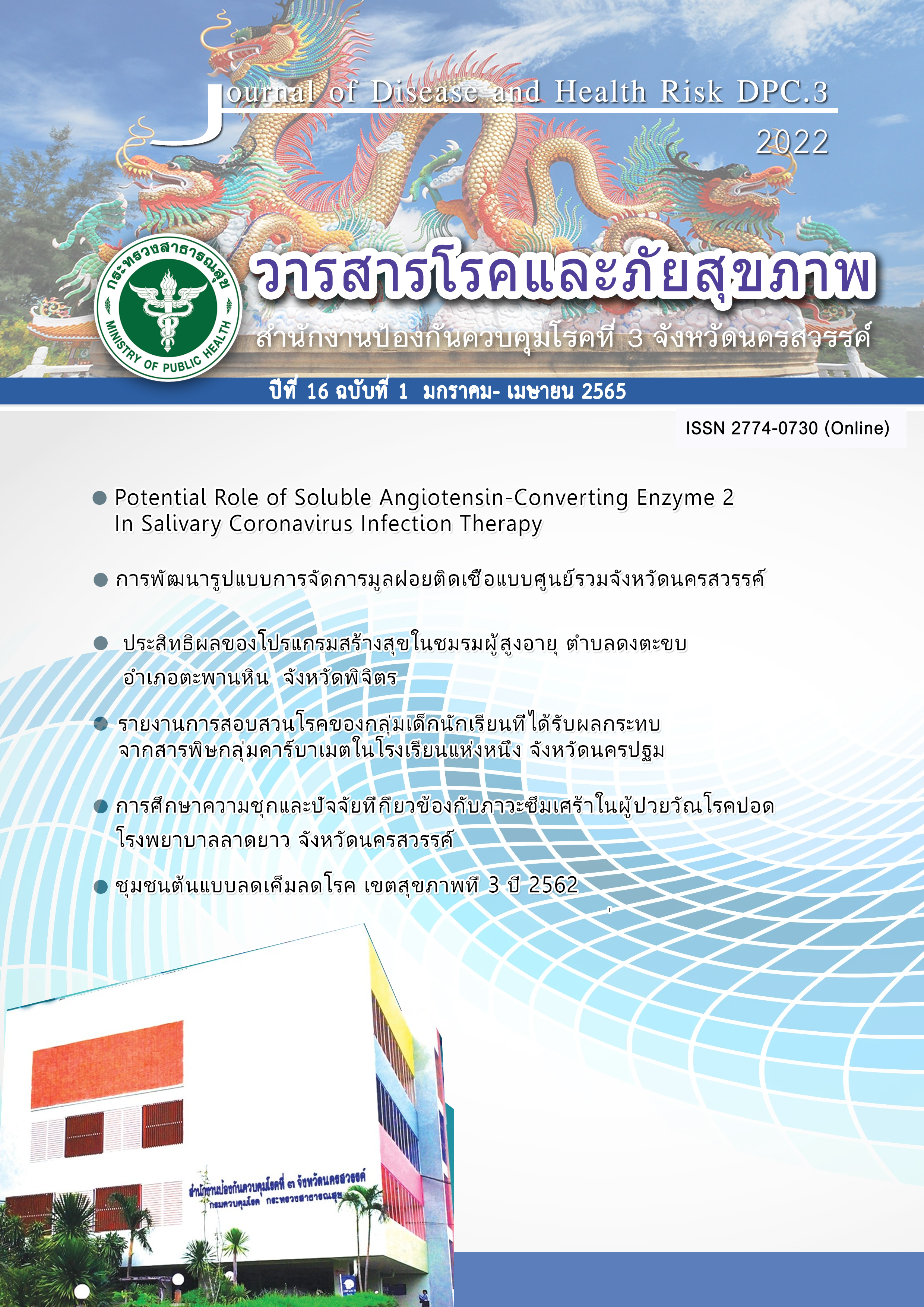ชุมชนต้นแบบลดเค็ม ลดโรค เขตสุขภาพที่ 3 ปี 2562
คำสำคัญ:
ชุมชนต้นแบบ, ชุมชนลดเสี่ยง ลดโรคบทคัดย่อ
การศึกษาครั้งนี้เป็นการวิจัยเชิงปฏิบัติการแบบมีส่วนร่วมโดยประยุกต์ใช้แนวทางการดำเนินงานป้องกันควบคุมโรคไม่ติดต่อเรื้อรังโดยยึดชุมชนเป็นฐาน: ชุมชนลดเสี่ยง ลดโรคไม่ติดต่อเรื้อรัง มีวัตถุประสงค์สองประการคือ เพื่อพัฒนาชุมชนต้นแบบการปรับเปลี่ยนพฤติกรรมการบริโภคเค็ม และเพื่อวัดประสิทธิผลรูปแบบชุมชนต้นแบบที่พัฒนาขึ้น การศึกษาแบบผสานวิธี แบ่งการศึกษาออกเป็นสองระยะ คือ ระยะที่1 พัฒนาชุมชนต้นแบบลดเค็มลดโรคเขตสุขภาพที่ 3 ระยะที่ 2 ดำเนินการตามมาตรการที่พัฒนาขึ้น จากนั้นดำเนินการเก็บข้อมูลเชิงคุณภาพโดยการสนทนากลุ่ม จากผู้ให้ข้อมูล จำนวน 10 คน สุ่มแบบเจาะจงและเก็บข้อมูลเชิงปริมาณด้วยแบบสำรวจพฤติกรรมการบริโภคอาหารรสเค็ม จากผู้นำชุมชน เจ้าหน้าที่ที่เกี่ยวข้อง อสม. แม่บ้านและเยาวชน จำนวน 40 คน สุ่มตัวอย่างอย่างเป็นระบบ วิเคราะห์ข้อมูลเชิงคุณภาพ ด้วยการวิเคราะห์เนื้อหา และข้อมูลเชิงปริมาณ ด้วยสถิติเชิงพรรณนาและวิเคราะห์ค่าเฉลี่ยเปรียบเทียบก่อน-หลังพฤติกรรมการบริโภคอาหารรสเค็มด้วยสถิติ paired samples t-test ผลการศึกษาพบว่า การพัฒนารูปแบบการปรับเปลี่ยนพฤติกรรม ประกอบด้วย 5 มาตรการได้แก่ 1.ประชาสัมพันธ์ 2.ขอความร่วมมือผู้เกี่ยวข้องร่วมดำเนินการ 3.อบรมให้ความรู้ 4.จัดเวทีชุมชน 5.ติดตามประเมินผล และการประเมินพฤติกรรมพบว่า กลุ่มตัวอย่างส่วนใหญ่มีพฤติกรรรมการบริโภคอาหารรสเค็มลดลง มีแนวโน้มดีขึ้น และค่าคะแนนเฉลี่ยพฤติกรรมการบริโภคหลังดำเนินการแตกต่างกันอย่างมีนัยสำคัญทางสถิติที่ระดับ 0.001 ดังนั้น เจ้าหน้าที่สาธารณสุขและหน่วยงานที่เกี่ยวข้องในชุมชนควรส่งเสริม สนับสนุนให้แกนนำชุมชนเป็นต้นแบบในการปรับเปลี่ยนพฤติกรรมและกระตุ้นประชาชนที่อยู่ในความดูแลมีพฤติกรรมการบริโภคที่ถูกต้องรวมทั้งควรขยายผลการศึกษาลักษณะนี้ไปยังพื้นที่อื่นที่มีปัญหาโรคไม่ติดต่อเรื้อรังต่อไป
เอกสารอ้างอิง
World Health Organization. Global Action Plan for the Prevention and Control of Noncommunicable Diseases2013-2020. Geneva: World Health Organization. 2013.
สำนักงานคณะกรรมการสุขภาพแห่งชาติ. มติสมัชชาสุขภาพแห่งชาติครั้งที่ 6 พ.ศ. 2556 [อินเตอร์เน็ต]. นนทบุรี : พิมพ์สิริพัฒนา, 2557 [ เข้าถึงเมื่อ 9 ธันวาคม 2562]. เข้าถึงได้จาก:http://www.sem100library.in.th/medias/b10583.pdf
สำนักงานคณะกรรมการอาหารและยา. รายงานวิจัยการสำรวจสถานการณ์การแสดงข้อมูลโภชนาการและปริมาณโซเดียมบนฉลากอาหารในผลิตภัณฑ์อาหารสำเร็จรูปที่พร้อมบริโภคทันที ปี 2555-2558.
สำนักงานคณะกรรมการสุขภาพแห่งชาติ. เอกสารหลักประกอบการพิจารณามติสมัชชา สุขภาพแห่งชาติครั้งที่ 8 พ.ศ. 2558. นโยบายการลดบริโภคเกลือและโซเดียมเพื่อลดโรคไม่ติดต่อ (NCDs). ระเบียบวาระที่ 2.4 สมัชชาสุขภาพ 8 / หลัก 4. 17 พฤศจิกายน 2558. [อินเตอร์เน็ต].2558. [ เข้าถึงเมื่อ 9 ธันวาคม 2564]. เข้าถึงได้จาก: https://3c5.com/Wowkt.
Aburto NJ, Hanson S, Gutierrez H, Hooper L, Elliott P, Cappuccio FP. Effect of increased potassium intake on cardiovascular risk factors and disease: systematic review and meta-analyses. BMJ. 2013 Apr 3;346:f1378. doi: 10.1136/bmj.f1378. PMID: 23558164; PMCID: PMC4816263.
วิชัย เอกพลากร, (บรรณาธิการ). รายงานการสำรวจสุขภาพประชาชนไทยโดยการตรวจร่างกายครั้งที่ 6 พ.ศ. 2562 - 2563. อักษรกราฟฟิคแอนด์ดีไซน์: กรุงเทพมหานคร. คณะแพทยศาสตร์โรงพยาบาลรามาธิบดีมหาวิทยาลัยมหิดล. 2564
วิชัย เอกพลากร. (บก.). รายงานการสำรวจสุขภาพประชาชนไทยโดยการตรวจร่างกาย ครั้งที่ 5 พ.ศ. 2557. อักษรกราฟฟิคแอนด์ดีไซน์: กรุงเทพมหานคร. สถาบันวิจัยระบบสาธารณสุข (สวรส.) 2559.
วิชัย เอกพลากร. (บก.). การสำรวจด้านโภชนาการ การสำรวจสุขภาพประชาชนไทยโดยการตรวจร่างกาย ครั้งที่ 4 พ .ศ. 2551-2552. นนทบุรี : สำนักงานสำรวจสุขภาพประชาชนไทย , 2553.
กองโภชนาการ กรมอนามัย กระทรวงสาธารณสุข และองค์การยูนิเซฟ สำนักงานประเทศไทยรายงานการสำรวจปริมาณการบริโภคโซเดียมคลอไรด์ของประชากรไทย; 2552.
สำนักงานสำรวจสุขภาพประชาชนไทย สถาบันวิจัยระบบสาธารณสุข รายงานการสำรวจการบริโภคอาหารของประชาชนไทย การสำรวจสุขภาพประชาชนไทยโดยการตรวจร่างกายครั้งที่ 4 พ.ศ. 2551-2552; มิถุนายน 2554.
สำนักโรคไม่ติดต่อ กรมควบคุมโรค กระทรวงสาธารณสุข. รายงานผลการทบทวนรูปแบบการดำเนินงานป้องกันการเกิดโรคไม่ติดต่อในวิถีชีวิต ด้วยการลดการบริโภคเกลือ. กรุงเทพฯ:องค์การสงเคราะห์ทหารผ่านศึก. สำนักโรคไม่ติดต่อ กรมควบคุมโรค กระทรวงสาธารณสุข. 2556.
Mozaffarian D, Fahimi S, Singh GM, Micha R, Khatibzadeh S, Engell RE. et al. Global Sodium Consumption and Death from Cardiovascular Causes. N Engl J Med.2014; 371:624-34.
He FJ, Li J, Macgregor GA. Effect of longer-term modest salt reduction on blood pressure. Cochrane Database Syst Rev. 2013 Apr 30;(4):CD004937.
Aburto NJ, Ziolkovska A, Hooper L, Elliott P, Cappuccio FP , Meerpohl JJ. Effect of lower sodium intake on health: systematic review and meta-analyses. BMJ (Clinical research ed.), 2013; 46, f1326. https://doi.org/10.1136/bmj.f1326.
สำนักโรคไม่ติดต่อ กรมควบคุมโรค. คู่มือการดำเนินงานป้องกันควบคุมโรคไม่ติดต่อเรื้อรัง โดยยึดชุมชนเป็นฐาน: ชุมชนลดเสี่ยงลดโรคไม่ติดต่อเรื้อรัง (CBI NCDs) สำหรับบุคลากรสาธารณสุขผู้รับผิดชอบโรคไม่ติดต่อเรื้อรัง ปี 2561. กรุงเทพฯ: บริษัทอิโมชั่นอาร์ต จำกัด. สำนักโรคไม่ติดต่อ กรมควบคุมโรค. 2561.
Standard report group in Ministry of Health. Critical NCD Illness Report [Internet]. 2019. [cited2020 Dec12].Available from:
https://hdcservice.moph.go.th/hdc/main/index.php
กลุ่มพัฒนานวัตกรรมและวิจัย สำนักงานป้องกันควบคุมโรคที่ 3 จังหวัดนครสวรรค์. แผนงานวิจัยด้านการป้องกัน ควบคุมโรคและภัยสุขภาพ พ.ศ.2563 – 2565. งานวิจัยและวารสาร. กลุ่มพัฒนานวัตกรรมและวิจัย สำนักงานป้องกันควบคุมโรคที่ 3 จังหวัดนครสวรรค์.2562.
MIS ศูนย์ข้อมูลสารสนเทศด้านสาธารณสุข สำนักงานสาธารณสุขจังหวัดพิจิตร. จำนวนประชากรแยกตามอายุและเพศ ปี 2561 รายอำเภอ ตำบล หมู่บ้าน.บ้านวังขอนซุง ม.09 ตำบลวังตะกู อำเภอบางมูลนาก จังหวัดพิจิตร. [อินเตอร์เน็ต]. 2561. [ เข้าถึงเมื่อ 14 มกราคม 2565]. เข้าถึงได้จาก: http://1ab.in/b1M5
สำนักโภชนาการ กรมอนามัย.แบบประเมินพฤติกรรมที่ทำให้ระดับ ความเค็ม ของคุณเพิ่มขึ้น : ข้อมูลและสื่อให้ความรู้ในการดำเนินกิจกรรม ; 2559
Sirikwan Pensuwan. Low salt… Health prometing development. academic database Phatthalung Provincial Public Health Office;2019 [cited 2019 Sep 22]. Available from: https://bit.ly/3Gu0msb
Nuttiwan Panmung, Khanitha Srisawat, Praphatsara Bunthawi. The experimental study of using the low salt intervention program in communities. Department of health Service Support Journal 2020;16:39-48
Som Nasa-arn, Thipaporn Rachagrai. Development of a Reduced Salty Intake Model in the High Blood Pressure Suspected Cases. Journal of the Office of Disease Prevention and Control 7, Khon Kaen 2020;3:99-110
ดาวน์โหลด
เผยแพร่แล้ว
รูปแบบการอ้างอิง
ฉบับ
ประเภทบทความ
สัญญาอนุญาต
ลิขสิทธิ์ (c) 2022 วารสารโรคและภัยสุขภาพ สำนักงานป้องกันควบคุมโรคที่ 3 จังหวัดนครสวรรค์

อนุญาตภายใต้เงื่อนไข Creative Commons Attribution-NonCommercial-NoDerivatives 4.0 International License.
ประกาศเกี่ยวกับลิขสิทธิ์
|
บทความที่เผยแพร่ในวารสารโรคและภัยสุขภาพสำนักงานป้องกันควบคุมโรคที่ 3 จังหวัดนครสวรรค์ ถือว่าเป็นผลงานทางวิชาการหรือการวิจัย และวิเคราะห์ ตลอดจนเป็นความเห็นส่วนตัวของผู้เขียน ไม่ใช่ความเห็นของสำนักงานป้องกันควบคุมโรคที่ 3 จังหวัดนครสวรรค์ หรือกองบรรณาธิการแต่ประการใด ผู้เขียนต้องรับผิดชอบต่อบทความของตน |
นโยบายความเป็นส่วนตัว
|
ชื่อและที่อยู่ อีเมล์ ที่ระบุในวารสารโรคและภัยสุขภาพสำนักงานป้องกันควบคุมโรคที่ 3 จังหวัดนครสวรรค์ จะใช้เพื่อระบุตามวัตถุประสงค์ของวารสารเท่านั้น และจะไม่นำไปใช้สำหรับวัตถุประสงค์อื่น หรือต่อบุคคลอื่น |









